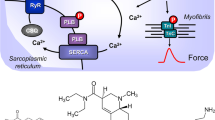Abstract
Our aim was to specify the 5-HT2 subtype selectivity of EGIS-7625 (1-benzyl-4-[(2-nitro-4-methyl-5-amino)-phenyl]-piperazine), a new 5-HT2B ligand, in receptor binding studies and characterize its pharmacology at 5-HT2A, 5-HT2B and 5-HT2C receptors in in vivo experiments and in isolated organs, in vitro. EGIS-7625 had high affinity for recombinant human 5-HT2B receptors (pK i = 9.0) but much weaker affinity for 5-HT2A and 5-HT2C receptors (pK i = 6.2 and 7.7, respectively). In the classic 5-HT2B test, EGIS-7625 produced a concentration-related parallel rightward shift in the concentration-response relationship for the 5-HT-induced smooth muscle constriction in rat stomach fundus strips with a pA2 of 9.4. On the other hand, EGIS-7625 was a weak competitive antagonist at 5-HT2A receptors as it shifted 5-HT-induced concentration-response curves to the right at high concentrations (pA2 = 6.7) in rabbit pulmonary artery strips. The m-chlorophenylpiperazine-induced hypomotility and hypophagia was only partially attenuated by EGIS-7625 even at a dose of 30 mg/kg i.p. while mianserin, a non-selective 5-HT antagonist was almost fully effective in these tests at 3 mg/kg i.p., suggesting weak antagonistic effect of EGIS-7625 at neuronal 5-HT2C receptors, in vivo. In conclusion, EGIS-7625 is a potent, selective and competitive 5-HT2B antagonist that seems to be a good research tool for the separation of the functional roles of vascular 5-HT2A and 5-HT2B receptors.
Similar content being viewed by others
References
Hoyer D, Clarke DE, Fozard JR, et al. International Union of Pharmacology classification of receptors for 5-hydroxytryptamine (Serotonin). Pharmacol Rev 1994; 46: 157-203.
Bonhaus DW, Flippin LA, Greenhouse RJ, et al. RS-127445: Aselective, high affinity, orally bioavailable 5-HT2B receptor Antagonist. Br J Pharmacol 1999; 127: 1075-1082.
Fitzgerald LW, Burn TC, Brown BS, et al. Possible role of valvular serotonin 5-HT(2B) receptors in the cardiopathy associated with fenfluramine. Mol Pharmacol 2000; 57: 75-81.
Knowles ID, Ramage AG. Evidence for a role for central 5-HT2B as well as 5-HT2A receptors in cardiovascular regulation in anaesthetized rats. Br J Pharmacol 1999; 128: 530-542.
Knowles ID, Ramage AG. Evidence that activation of central 5-HT(2B) receptors causes renal sympathoexcitation in anaesthetized rats. Br J Pharmacol 2000; 129: 177-183.
Kennett GA, Ainsworth K, Trail B, Blackburn TP. BW 723C86, a 5-HT2B receptor agonist, causes hyperphagia and reduced grooming in rats. Neuropharmacology 1997; 36: 233-239.
Kennett GA, Trail B, Bright F. Anxiolytic-like actions ofBW 723C86 in the rat Vogel conflict test are 5-HT2B receptor mediated. Neuropharmacology 1998; 37: 1603-1610.
Meneses A. 5-HT system and cognition. Neurosci Biobehav Rev 1999; 23: 1111-1125.
Clineschmidt BV, Reiss DR, Pettibone DJ, Robinson JL. Characterisation of 5-hydroxytryptamine receptors in rat stomach fundus. J Pharmacol Exp Ther 1985; 235: 696-708.
Ellis ES, Byrne C, Murphy OE, Tilford NS, Baxter GS. Mediation by 5-hydroxytryptamine2B receptors of endotheliumdependent relaxation in rat jugular vein. Br J Pharmacol 1995; 114: 400-404.
Watts SW, Harris B. Is functional upregulation of the 5-HT2B receptor in deoxycorticosterone acetate salt-treated rats blood pressure dependent? Gen Pharmacol 1999; 33: 439-447.
Watts SW, Fink GD. 5-HT2B receptor antagonist LY-272015 is antihypertensive in DOCA-salt-hypertensive rats. Am J Physiol 1999; 276: H944-952.
Baxter GS. Novel discriminatory ligands for 5-HT2B receptors. !Behav Brain Res 1996; 73: 149-152.
Cohen M, Audia J, Nelson D. 5-HT2B receptors: The road to therapeutic application. ID Drug Alert 1997; 2: 1-5.
Kovács A, Schmidt É, Tihanyi K, Egyed A, Szénási G. Pharmacological effects of EGIS-7625, a new and selective 5-HT2B blocker. Fund Clin Pharmacol 1999; 13(Suppl. 1): 281s, PT86.
Leysen JE, Niemegeers CJE, Van Nueten JM, Laduron PM. [3H]Ketanserin (R 41 468), a Selective 3H-Ligand for Serotonin2 receptor Binding Sites. Mol Pharmacol 1981; 21: 301-314.
Peroutka SJ. Pharmacological differentiation and characterization of 5-HT1A, 5-HT1B, and 5-HT1C binding sites in rat frontal cortex. J Neurochem 1986; 47: 529-540.
Pazos A, Hoyer D, Palacios JM. The binding of serotonergic ligands to the porcine choroid plexus: Characterization of a new type of serotonin recognition site. Eur J Pharmacol 1985; 106: 539-546.
Baxter GS, Murphy OE, Blackburn TP. Further characterization of 5-hydroxytryptamine receptors (putative 5-HT2B) in rat stomach fundus longitudinal muscle. Br J Pharmacol 1994; 112: 323-331.
Prinssen EP, Koek W, Kleven MS. The effects of antipsychotics with 5-HT2C receptor affinity in behavioral assays selective for 5-HT2C receptor antagonist properties of compound. Eur J Pharmacol 2000; 388: 57-67.
Arunlakshana O, Schild HO. Some quantitative uses of drug antagonists. Br J Pharmacol 1959; 14: 48-58.
Van Rossum JM. Cumulative dose-response curves. II.Technique for the making of dose-response curves in isolated organs and the evaluation of drug parameters. Arch Int Pharmacodyn 1963; 143: 99-330.
Bonhaus DW, Bach C, De Souza A, et al. The pharmacology and distribution of human 5-hydroxytryptamine2B (5-HT2B) receptor gene products: Comparison with 5-HT2A and 5-HT2C receptors. Br J Pharmacol 1995; 115: 622-628.
Glusa E, Pertz HH. Further evidence that 5-HT-induced relaxation of pig pulmonary artery is mediated by endothelial 5-HT2B receptors. Br J Pharmacol 2000; 130: 692-698.
Bonhaus DW, Weinhardt KK, Taylor M, et al. RS-102221: A novel high affinity and selective, 5-HT2C receptor antagonist. Neuropharmacology 1997; 36: 621-629.
Martin JR, Bos M, Jenck F, et al. 5-HT2C receptor agonists: Pharmacological characteristics and therapeutic potential. J Pharmacol Exp Ther 1998; 286: 913-924.
Wainscott DB, Lucaites VL, Kursar JD, Baez M, Nelson DL. Pharmacologic Characterization of the Human 5-Hydroxytryptamine2B Receptor: Evidence for Species Differences. J Pharmacol Exp Ther 1996; 276: 720-727.
Choi DS, Kellermann O, Richard S, et al. Mouse 5-HT2B receptor-mediated serotonin trophic functions. Ann NY Acad Sci 1998; 861: 67-73.
Author information
Authors and Affiliations
Rights and permissions
About this article
Cite this article
Kovács, A., Gacsályi, I., Wellmann, J. et al. Effects of EGIS-7625, a Selective and Competitive 5-HT2B Receptor Antagonist. Cardiovasc Drugs Ther 17, 427–434 (2003). https://doi.org/10.1023/B:CARD.0000015857.96371.43
Issue Date:
DOI: https://doi.org/10.1023/B:CARD.0000015857.96371.43




